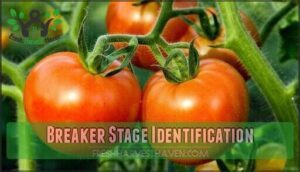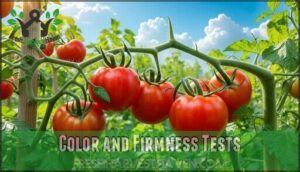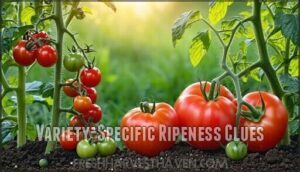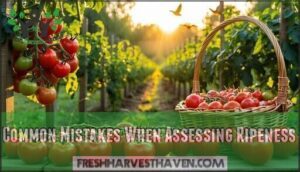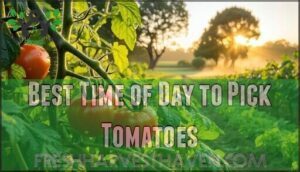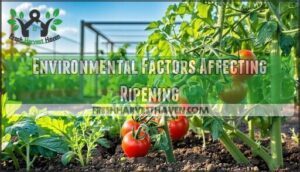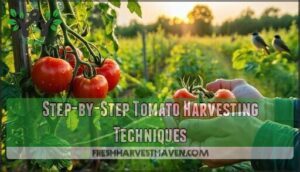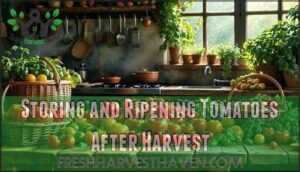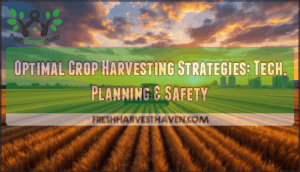This site is supported by our readers. We may earn a commission, at no cost to you, if you purchase through links.
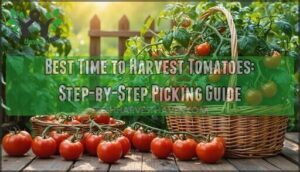 Most gardeners wait too long. They watch their tomatoes turn completely red on the vine, thinking full color equals peak flavor—but by then, sugars have peaked and decline has already begun. The breaker stage, when just 10-30% of the fruit shows color, is actually when you should reach for your harvest basket.
Most gardeners wait too long. They watch their tomatoes turn completely red on the vine, thinking full color equals peak flavor—but by then, sugars have peaked and decline has already begun. The breaker stage, when just 10-30% of the fruit shows color, is actually when you should reach for your harvest basket.
At this point, tomatoes will ripen beautifully off the vine while developing better flavor and texture than if left to fully mature in the garden. Temperature plays a bigger role than most people realize: above 86°F, ripening stops altogether, and those picture-perfect tomatoes baking in summer heat are losing quality by the hour.
The difference between a mealy, flavorless tomato and one that tastes like concentrated sunshine often comes down to picking at the right moment—not just the right color. Learning to read the subtle signs of readiness—the slight give when you press gently, the way morning dew sits on the skin, the exact shift from matte to glossy—transforms your harvest from guesswork into precision.
Table Of Contents
- Key Takeaways
- Key Signs Tomatoes Are Ready to Harvest
- Best Time of Day to Pick Tomatoes
- Environmental Factors Affecting Ripening
- Step-by-Step Tomato Harvesting Techniques
- Storing and Ripening Tomatoes After Harvest
- Frequently Asked Questions (FAQs)
- Should I pick my tomatoes before they turn red?
- What month are tomatoes ready to pick?
- Can you leave tomatoes on the vine too long?
- When should I pull up my tomatoes?
- How do you know tomatoes are ready?
- Can you eat green tomatoes safely?
- Should you wash tomatoes before storing?
- How long do harvested tomatoes last?
- What tools are best for harvesting?
- How do determinate and indeterminate varieties differ for harvest timing?
- Conclusion
Key Takeaways
- Pick tomatoes at the breaker stage (10-30% color) rather than waiting for full ripeness, as they’ll develop better flavor and texture off the vine while avoiding heat damage above 86°F that halts ripening and degrades quality.
- Harvest in the morning after dew dries for the firmest fruit with concentrated sugars, since afternoon heat softens tomatoes and makes them prone to bruising while wet conditions spread fungal diseases.
- Store breaker-stage tomatoes at room temperature (70-75°F) with good air circulation until fully colored, and only refrigerate very ripe fruit if absolutely necessary since cold storage destroys flavor compounds.
- Adjust your picking approach by variety—cherry tomatoes ripen faster and stay firm longer, while heirlooms may show green shoulders even when mature, so focus on gentle give and texture rather than color alone.
Key Signs Tomatoes Are Ready to Harvest
Picking your tomatoes at the right time makes all the difference between bland supermarket flavor and that perfect garden-fresh taste. Here’s what signals peak ripeness.
Breaker Stage Identification
The breaker stage is your sweet spot—that magic moment when a tomato shifts from purely green to showing its first blush of color, signaling it’s ready to leave the vine without sacrificing flavor. Here’s how to identify it:
- Color changes: Look for pinkish or yellowish tones appearing on the blossom end (opposite the stem), indicating fruit maturity has peaked.
- Skin texture: The surface loses its matte finish and develops a subtle glossiness as ripening signs emerge.
- Harvest timing: Act when 10-30% color develops—this ensures best tomato ripening indoors while protecting against weather damage.
Color and Firmness Tests
Once you spot that first blush of color, confirm ripeness with two quick tests. First, check for even color across the fruit’s skin. Then, gently squeeze with your fingertips. Ripe tomatoes give a little but bounce back, signaling it’s time to pick.
These signs and texture checks help you harvest at peak maturity.
Watch for these signs and feel the texture to know you’re picking at just the right moment.
Variety-Specific Ripeness Clues
Different tomato types don’t always follow the same ripening patterns, so you’ll want to adjust your approach. Cherry tomatoes ripen faster and stay firmer longer, while heirlooms may show green shoulders even when fully mature. Here’s what to watch for:
- Cherry varieties: Look for deep color and slight give—they stay firm even past the breaker stage
- Roma types: Expect a glossy, uniform red with a firm texture that’s perfect for sauces
- Heirloom beauties: Focus on softness rather than color; streaks and shoulders are normal
- Paste tomatoes: Wait until they’re bright red and easily separate from the vine
Understanding tomato ripeness signs is key for harvesting at the right time. Match your harvesting techniques to each variety’s maturity signs for the best results.
Common Mistakes When Assessing Ripeness
Even seasoned gardeners sometimes misjudge when tomatoes are ripe, relying too much on color or waiting for a perfect red that never appears. Missing the breaker stage means you’ll end up with overripe tomatoes prone to damage.
Avoid squeezing too hard and remember that different tomato varieties ripen differently. Poor timing due to these color mistakes can ruin the fruit’s quality and flavor.
Check firmness and texture alongside other ripeness signs for consistent results.
If you pair firmness and texture with the other signs, you’ll nail the timing every time.
Best Time of Day to Pick Tomatoes
Timing your harvest right can make the difference between firm, flavorful tomatoes and ones that split or spoil before you get them to the kitchen. The time of day you pick affects everything from how long your tomatoes will store to how much flavor they’ll deliver.
Let’s look at when to reach for those ripe fruits and what conditions work best for harvesting.
Here’s what you need to know about timing and conditions for the best harvest.
Morning Vs. Afternoon Harvesting
The timing of your harvest matters more than you might realize for tomato quality. Morning is the clear winner for picking tomatoes.
After a cool night, they’re at their firmest, with sugars concentrated and moisture perfectly balanced. The afternoon heat quickly softens them, making them more prone to bruising.
This strategy isn’t about convenience—it’s about capturing peak flavor at the ideal moment.
It’s not about making your day easier—it’s about getting the best flavor when tomatoes are at their peak.
Effects of Dew and Moisture
Waiting for dew to dry before you pick isn’t just an old gardener’s habit—it’s a smart move that protects your harvest from disease and damage. Wet tomatoes spread fungal spores through your hands and tools, compromising future crops.
Dew formation increases moisture levels overnight, and high humidity control challenges arise during morning harvest. Let water absorption stabilize first—your tomatoes will handle better, and you’ll avoid introducing rot during critical tomato ripening stages.
Weather Considerations for Picking
Check weather forecasts before heading out—temperature limits matter more than you’d think. Tomatoes stop ripening above 86°F and suffer chilling injury below 50°F, so harvest timing becomes critical during extreme conditions.
Storm impacts can lead to cracking rates over 30% after heavy rain, while morning harvest during stable weather (low wind, 60–80% humidity) keeps tomatoes firm and extends shelf life by 30%. Climate effects demand flexibility in your picking schedule.
Understanding temperature effects is key for healthy tomato growth and harvest.
Environmental Factors Affecting Ripening
Your tomatoes don’t ripen in a vacuum—they respond to everything happening around them. Temperature swings, sunlight hours, and moisture levels all play a role in how quickly your fruit develops color and flavor.
Your tomatoes don’t ripen in a vacuum—they respond to everything happening around them. Temperature swings, sunlight hours, and moisture levels all play a role in how quickly your fruit develops color and flavor.
Here’s what you need to know about the environmental factors that control your harvest timing.
Temperature and Sunlight Impact
Think of temperature and sunlight as your tomatoes’ thermostat and flavor switch. You’ll get the best ripening when daytime temperatures hover between 75–85°F and nights stay around 60–70°F.
When the mercury climbs above 85°F, pigment production stalls, leaving fruit yellowish or partially green. Morning harvest works best since cooler temps preserve firmness.
Heat stress above 88°F can halt ripening altogether, while insufficient sunlight—less than 6–8 hours daily—delays maturation and reduces sweetness noticeably.
Humidity and Rainfall Influences
Too much water can be just as risky as not enough—excess humidity and sudden downpours trigger a perfect storm for split skins, diluted flavor, and fungal invasion.
Rainfall patterns dramatically affect soil moisture and evapotranspiration rates during tomato ripening stages. When water stress swings wildly, fruit absorbs moisture faster than skin can stretch, causing cracks right before your tomato harvest.
Monitor weather conditions closely—pick ripe fruit before heavy rain to preserve harvesting tomatoes for quality.
Risks of Leaving Tomatoes Too Long
Leaving tomatoes on the vine too long is a risky gamble with nature. You’re inviting pests, diseases, and unpredictable weather to ruin your harvest in an instant.
Overripe tomatoes become more vulnerable to pests and diseases, and their skins can crack from excess moisture. As sugars break down, flavor fades, and the ideal harvesting window quickly closes.
To get the best quality, pick tomatoes at their peak ripeness—knowing when to stop is key.
For the best flavor and texture, harvest tomatoes when they’ve just reached full color—timing matters more than you’d think.
Step-by-Step Tomato Harvesting Techniques
Knowing when to pick is only half the battle—how you harvest matters just as much. The right technique protects your tomatoes from damage and keeps them flavorful for days after they leave the vine.
Let’s walk through the best ways to pick different types of tomatoes without bruising or splitting them.
Here’s how to pick each type without damaging them.
Gentle Picking Methods
When you’re ready to pick, use a gentle twist-and-lift motion instead of pulling straight down—this simple technique ensures a clean harvest without damaging the stem, which can leave the plant vulnerable to disease.
Hold the fruit with one hand while twisting the stem with the other, especially when harvesting tomatoes at the breaker stage. This method protects both the fruit and the plant, helping your crop monitoring efforts result in perfect, unblemished tomatoes.
Handling to Prevent Bruising
Once your tomatoes are off the vine, treat them gently—firm pressure or rough handling can leave invisible bruises that turn into soft spots within a day or two.
Line your harvest container with a soft cloth for cushioning, and place tomatoes carefully rather than tossing them in.
This careful postharvest care keeps the skin protected during the breaker stage and beyond, making sure your tomatoes stay firm through the gentle squeeze test.
Harvesting Different Tomato Types (Cherry, Heirloom, Etc.)
Not all tomatoes ripen the same way—cherry types, sprawling heirlooms, and thick-walled paste varieties each need a slightly different approach when it’s time to pick.
Cherry tomatoes come off easily with a gentle twist once they’re fully colored, while beefsteak and heirloom varieties benefit from breaker-stage harvesting to prevent splitting.
Roma and paste types can stay on the vine longer since their thick walls resist cracking better than thin-skinned tomato varieties.
Storing and Ripening Tomatoes After Harvest
Once you’ve picked your tomatoes, knowing how to store them properly makes all the difference in preserving their flavor and extending their freshness. The way you handle ripening and storage directly affects taste, texture, and how long your harvest will last.
Let’s walk through the best practices for keeping your tomatoes at peak quality after they leave the vine.
Here’s how to keep your tomatoes tasting great and lasting longer once they’re off the plant.
Room Temperature Vs. Refrigeration
Your storage decisions after harvest can make or break the flavor you worked all season to develop. Here’s what you need to know about temperature control and best harvesting practices:
Storage after harvest determines whether you’ll enjoy the flavors you spent months cultivating. Temperature control matters more than most gardeners realize.
- Refrigeration timing: Only refrigerate very ripe tomatoes if you can’t use them within a day, accepting some flavor trade-off for extended fruit shelf life
- Humidity effects: Store in a dry spot with good air circulation to prevent moisture buildup and spoilage during tomato ripening techniques
Off-Vine Ripening Tips
Picking tomatoes at the breaker stage doesn’t mean you’ve missed out on that sun-kissed flavor—you can coax that same sweetness right on your kitchen counter with a few simple tricks.
Place your breaker-stage tomatoes stem-side down on ripening trays in a spot with indirect light and good air circulation. The fruit naturally produces ethylene gas that speeds up fruit ripening, so grouping them loosely helps control the process without causing soft spots.
| Factor | Best Practice |
|---|---|
| Temperature | Keep indoor climate at 70-75°F for ideal tomato ripening techniques |
| Light | Indirect sunlight speeds color without overheating |
| Spacing | Leave gaps between fruits for ethylene control and air flow |
| Monitoring | Check daily for vine-ripe color and gentle give |
| Handling | Use gentle post-harvest care to prevent bruising during off-vine ripening |
Checking for Spoilage and Quality
Even perfectly ripened tomatoes can turn south quickly if you miss the subtle signs of decay, so knowing what to look for keeps your harvest from going to waste. Run your fruit inspection by checking for soft spots, wrinkled skin, or dark patches—classic spoilage signs that signal your quality control window is closing.
Press gently during freshness tests; bruised areas feel mushy and spread fast. Proper damage assessment now protects your entire batch from one overripe fruit.
Maximizing Shelf Life and Flavor
You can double the shelf life of your tomatoes with just a few postharvest tweaks. Smart harvesting and ripening control help preserve both flavor and nutrients—tomatoes stored around 14°C last up to 15 days while staying fresh.
For serious shelf life extension:
- Store at cool temperatures (13-18°C) instead of very cold or room temp for better appearance and ripening results
- Keep mature green tomatoes in evaporative cool chambers to hold onto vitamin C and stay fresh for 21 days
- Use natural coatings like whey protein or wax to slow ripening by 50% and maintain quality
These storage methods help you harvest tomatoes that last longer.
Frequently Asked Questions (FAQs)
Should I pick my tomatoes before they turn red?
Yes, you can—and often should—pick tomatoes at the breaker stage, when they’re mostly green with a hint of pink.
They’ll ripen beautifully off the vine while dodging pests, cracks, and weather damage that threaten fully red fruit.
What month are tomatoes ready to pick?
In most regions, tomatoes reach peak harvest between July and September, though your regional variations and weather patterns play a major role.
Best time to pick tomatoes depends on your tomato calendar—early varieties ripen by midsummer, while late-season types extend harvest seasons into fall.
Can you leave tomatoes on the vine too long?
Absolutely—leaving tomatoes on the vine too long invites trouble. Over-ripening makes them vulnerable to cracking, pest damage, and decay, especially during rainy spells or temperature swings.
Harvest timing is key: pick at the breaker stage to avoid fruit spoilage and use proper techniques to preserve flavor.
When should I pull up my tomatoes?
Pull up your tomato plants once frost threatens or when production drops noticeably. Determinate varieties finish fruiting in one flush, while indeterminate types produce until cold weather hits.
Harvest timing and vine management depend on your region’s first frost date and the plant’s fruit maturity stage. Monitoring tomato ripening stages helps you maximize crop yield with effective harvesting techniques before removing plants entirely.
How do you know tomatoes are ready?
Watching for ripeness signs in tomatoes is like reading a sunset from blossom end to stem. Look for color shifts at the breaker stage, when green turns to pink, and check the skin’s firmness.
Ethylene production drives the ripening process, so understanding this helps guide your harvesting techniques and timing for the best quality.
Can you eat green tomatoes safely?
You can safely eat green tomatoes, though they contain small amounts of solanine—a compound that’s mildly toxic in large quantities. Cooking neutralizes most concerns, making fried green tomatoes a popular choice.
Raw consumption is generally fine for most people, but avoid eating them if you’re sensitive to nightshades.
Should you wash tomatoes before storing?
You might think washing tomatoes before storage keeps them fresh, but that’s a myth—moisture actually invites mold and bacterial growth.
Skip washing until you’re ready to eat them; this simple step preserves fruit quality and extends shelf life naturally.
How long do harvested tomatoes last?
Freshly harvested tomatoes usually last five to seven days at room temperature, depending on how ripe they were when picked and how they’re stored. Keeping them in a cool, dry place away from direct sunlight helps them last longer.
Checking for soft spots daily during ripening can really improve how long they stay fresh after harvest.
What tools are best for harvesting?
You don’t need fancy equipment—just a few simple tools make all the difference when it’s time to pick tomatoes. Gardening gloves protect your hands, while pruning shears or fruit clippers give you clean cuts on stubborn stems.
Harvest baskets cradle your bounty gently, preventing bruising and helping your careful harvesting techniques pay off with perfect, unblemished fruit.
How do determinate and indeterminate varieties differ for harvest timing?
Determinate varieties ripen all at once, allowing a concentrated harvest over two weeks.
Indeterminate types produce continuously throughout the season, requiring regular picking every few days as individual tomatoes reach their breaker stage.
Conclusion
Imagine stepping into your garden on a perfect August morning, basket in hand, picking tomatoes at their peak ripeness. Knowing the best time to harvest tomatoes turns this vision into reality—picking at the breaker stage, harvesting in the morning, and careful treatment guarantee each fruit reaches its full flavor.
You’ve learned to spot ripeness signs, work with weather patterns, and store your harvest for the best taste. Now you’re ready to pick like a pro, turning each season’s crop into the delicious sunshine your table deserves.
- https://www.creativevegetablegardener.com/how-long-does-it-take-for-tomatoes-to-grow/
- https://extension.psu.edu/is-this-tomato-ready-to-harvest/
- https://pmc.ncbi.nlm.nih.gov/articles/PMC11257922/
- https://publishing.emanresearch.org/Journal/Abstract/agriculture-2110046
- https://pubmed.ncbi.nlm.nih.gov/16657771/

